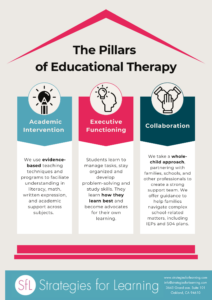No products in the cart.

By Deshon C. Smith, M.S.
Clinician at Strategies for Learning
Introduction to Current Practices
There are several advantages to using music in a learning environment whether it’s being delivered remotely or in a live environment. Cognitive exercises for the brain allow children to uncover patterns from sound or rhythm, bridging the gap between short-term memory and long term memory. A simple example is the English Alphabet. The first 7 letters are sung, followed by 9, 3-count twice, then 2-count twice. Children have various learning styles and music can encourage students to tap into those major sensory pathways which are hearing, sight and speaking.
Music-Themed Technologies
Kahoot is an easy learning application where you can create trivia questions which display from a computer. Logging in just requires entering a code at https://kahoot.it/. For a free account you can create up to 5 questions and set time limits. Subscribed members can change the background music and themes. This is great for hosting a study group where kids can experience positive competition.
DuoLingo offers language immersion software. Users can put words in order of how they sound and vice versa. With multiple users the facilitator can lead dance breaks for every sentence pronounced. Part of learning language is identifying cultural themes. For example, a party theme would have words such as cake, music, gathering and balloons. When students are actively engaged with the vocabulary, a song in that language can be included. Advanced language students can watch foreign movies with subtitles followed by knowledge check questions.
The computer application compatible with Android and iPhone, Zenbeats works on virtually all PCs and digital tablets. This tool is great for students who have the creativity to prepare for exams with preprogrammed tones. Chapter notes relevant to a study guide or Chapter Summary can be drafted by the student. Questions from their notes can be asked in the form of a recording. Correct answers can result in a positive rhythm, while incorrect responses are dubbed as repeats.
The creation of music on the smartphone or laptop is advantageous by reducing eye strain and multi-tasking.
Regulation of Emotions (Quick Activity)
Have your child set a reminder on their smartphone using a ringtone that will easily grab their attention. This ringtone is a unique way for starting a task that might otherwise be forgotten. Your child’s favorite songs can be downloaded from iTunes for iPhone and Google Music if using an Android.
Studies have shown that students perform better on their homework and academics when they choose a controlled environment to study. Classical, jazz and soft rock are musical genres which tend to calm individuals who experience anxiety and stress levels. Every student is unique and so their music interests, common moods and sustained-attention abilities are factors to consider when implementing music into a child’s learning. Testing environments tend to be more competitive and undesirable, but students can master the content through independent study. Overcoming test anxiety by use of music can be further studied here. Everybody has a natural rhythm that starts from the heartbeat. Educators, parents and students themselves can apply music theory and technologies to improve how they learn.
Sources






